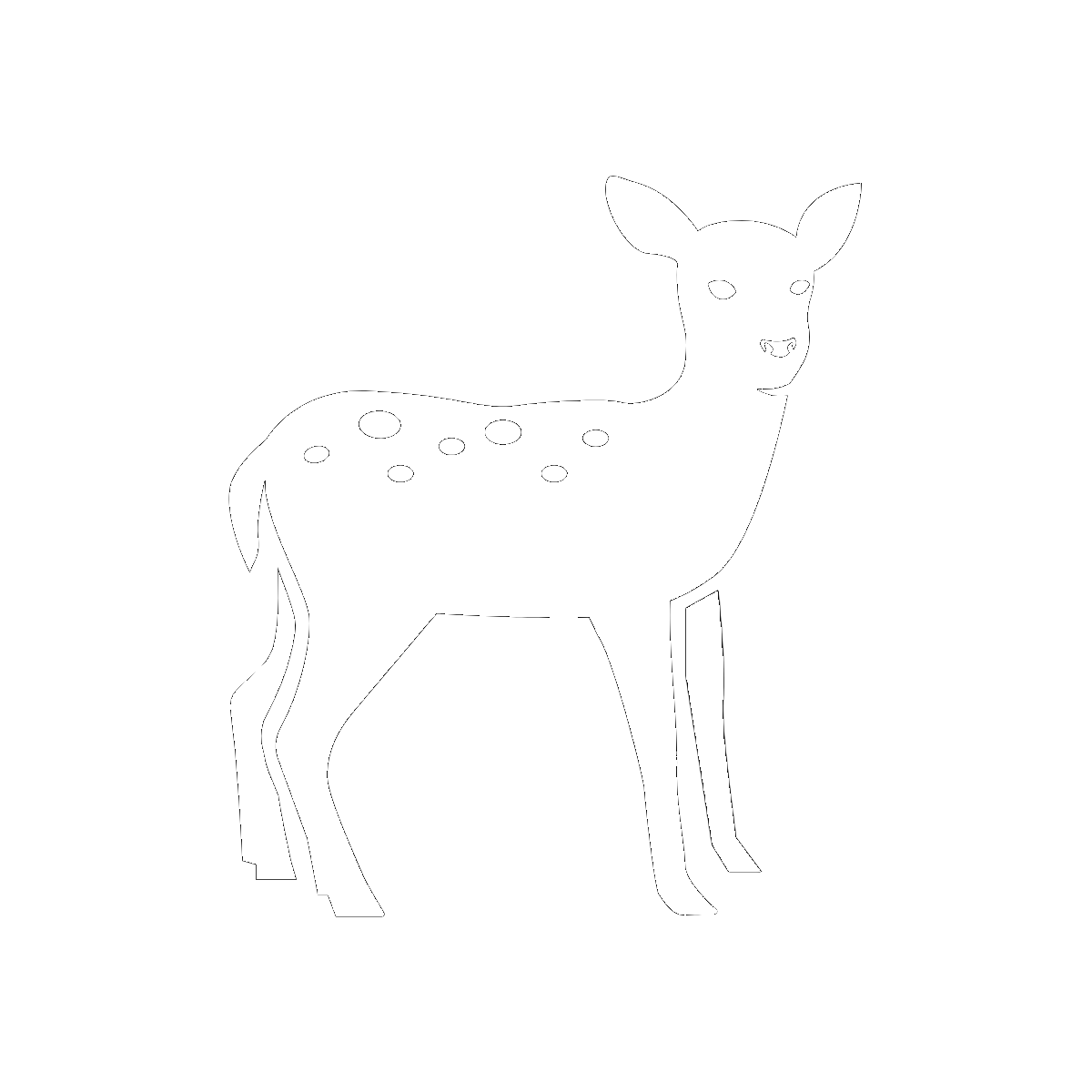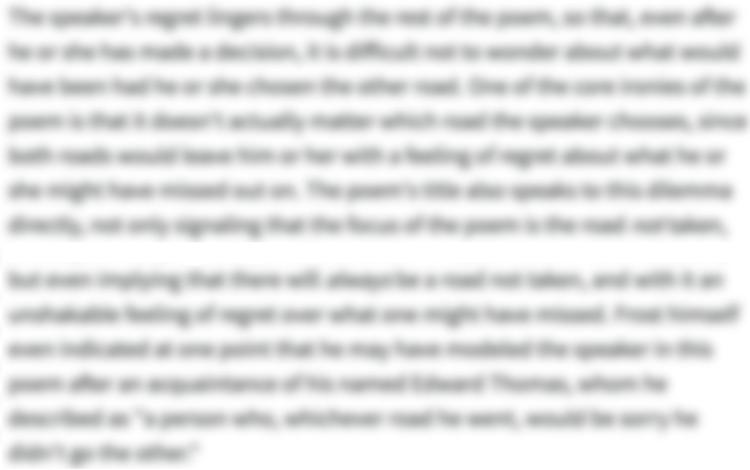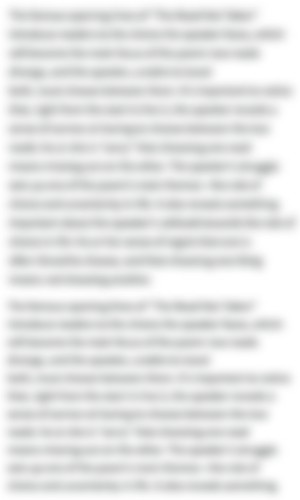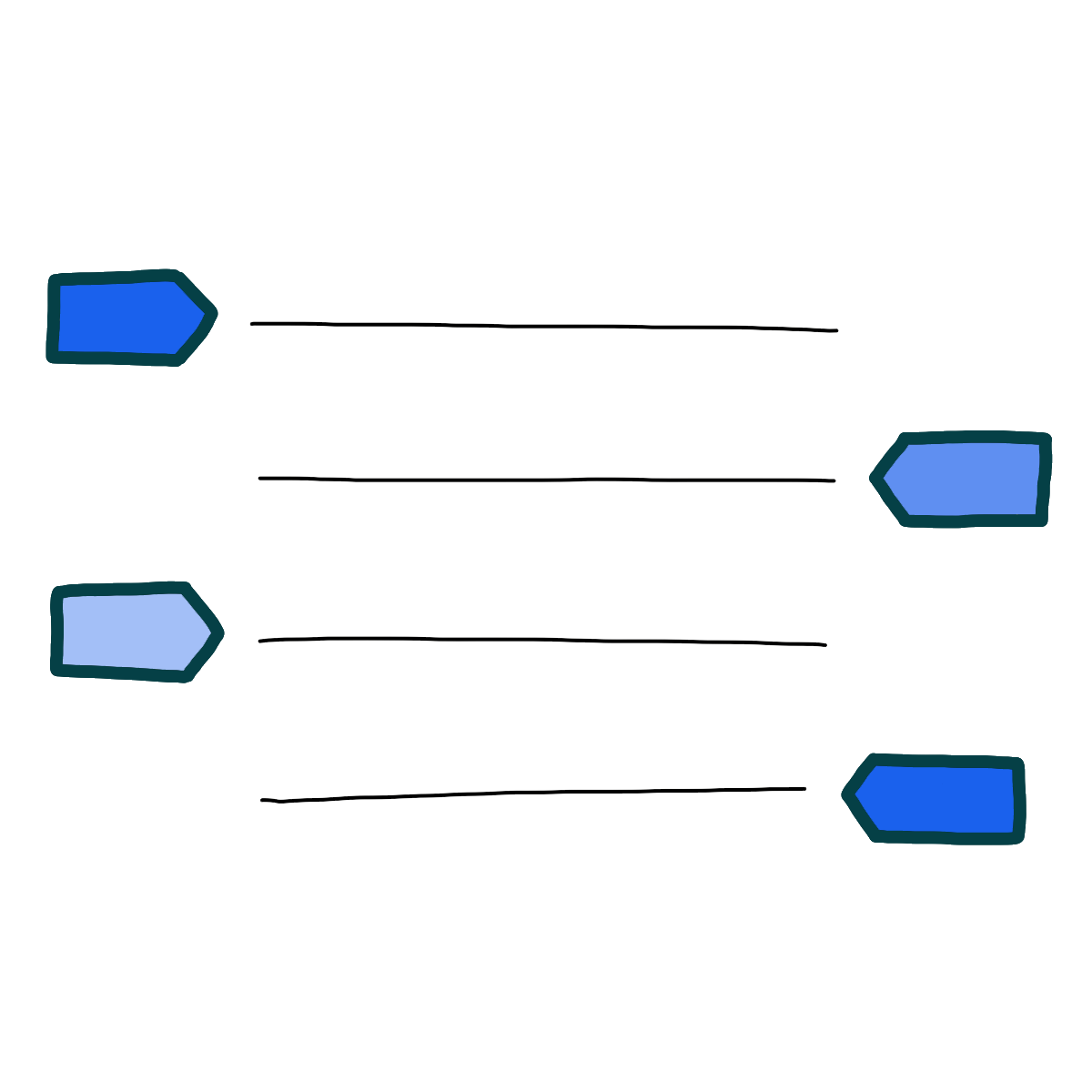-
“Traveling through the Dark” Introduction
-
The American poet William Stafford published "Traveling through the Dark" in 1962. While driving on a narrow road at night, the poem's speaker finds a dead deer and decides to move the body so that it won't cause other drivers to dangerously swerve out of the way. Upon dragging the deer toward a canyon, however, the speaker discovers that she was pregnant at the time of her death—and that her fawn is still alive inside her womb. Deciding that the fawn is doomed no matter what, the speaker only hesitates for a moment before pushing the doe off the road and into the river below. Through this unsettling incident, the poem highlights the destructive impact that human technology can have on the natural world, while also exploring the idea of moral responsibility and the choices people make when confronted with death. The poem is based on a real incident in Stafford's life.
-
-
“Traveling through the Dark” Summary
-
The speaker describes driving through the night and finding a dead deer on the side of the road that runs along the Wilson River in Oregon. Normally, the speaker says, the best thing to do in these situations is to roll the deer off the road and into the canyon below; since the road is so narrow, the deer's body would create a dangerous obstacle that would force other drivers to swerve and potentially get killed themselves.
The speaker trudged behind the car, its taillights illuminating the dark night, and stood next to the unmoving mass of the dead deer, which seemed to have been killed recently. The doe's body was already stiff with rigor mortis and beginning to cool. Upon dragging her off the road, the speaker noticed that her stomach was swollen.
Upon touching the doe's warm side, the speaker realized why this was the case: she was pregnant, a living fawn still insider her and waiting to be born—something that would never happen. Standing on the side of the mountain road, the speaker paused, unsure of what to do.
The car beamed its dim parking lights into the night before it, while its engine growled gently beneath the hood. The speaker stood in the car's warm exhaust, which glowed red in the glare of the taillights. The speaker, the car, the doe, and the unborn fawn were surrounded by a silence so deep it felt like nature itself was listening to them.
The speaker thought about everyone involved in this incident. This was the speaker's only form of hesitation before pushing the doe and its fawn off the edge of the road and into the river below.
-
-
“Traveling through the Dark” Themes
-

Death and Morality
“Traveling through the Dark” is a poem about coming face to face with death. The speaker is faced with a no-win situation, understanding that moving the dead doe's body out of the road will potentially save other drivers, but also that doing so will kill her unborn fawn. Death is often unfair and inevitable, the poem thus implies, with the speaker deciding that the best thing to do in this situation is just to limit death's reach as much as possible.
Confronted with the body of the dead doe, the speaker fears that leaving it on the road will “make more dead.” Despite not creating this situation in the first place, the speaker clearly feels a sense of moral responsibility when it comes to keeping the road safe. The speaker thus makes a calculated attempt to limit suffering, deciding to move the doe to save other drivers—despite the fact that doing so will guarantee the unborn fawn's death.
This decision is understandable; the fawn is doomed regardless of what the speaker does. Even if the speaker attempted a heroic rescue, it's unlikely the fawn would survive without its mother. Yet despite seeming like the right thing to do, this doesn’t make going through with this plan any easier. Pushing the doe into the river effectively makes the speaker an active participant in the fawn’s death rather than an innocent bystander. The fawn would have died anyway, but now the speaker is the one killing it.
Thus, while it’s perhaps simple enough to prioritize human life in theory, the poem implies that actually choosing one life over another isn't all that easy. The deer and her unborn baby aren't just numbers in a calculation; life and death aren't abstract philosophical concepts for the speaker in this moment, and the speaker realizes that it’s not always possible to make clear-cut moral choices when it comes to mortality.
Faced with such a dilemma, the speaker "hesitates." The poem's sudden focus on the ominous, waiting car implies that the speaker is tempted to drive off and leave the deer right where she is—effectively relinquishing all responsibility for the situation and leaving it to whoever is unlucky enough to drive along next.
Yet this wavering—this "swerving"—lasts only a moment. The speaker ultimately pushes the deer "into the river," which can be read both as a choice to protect other drivers, and, perhaps, a means of simply getting this terrible situation over with and moving on. The poem ends on a note of sadness, with the speaker seemingly not feeling all that good about doing what was right.
Where this theme appears in the poem:- Lines 1-18
-

Humanity vs. Nature
“Traveling through the Dark” explores the conflict between humanity and the natural world, and specifically meditates on the destructive potential of technology. The doe was presumably killed in a hit-and-run, with the driver who struck her not even bothering to move her body. Through this incident, the poem highlights technology's devastating effect on nature, as well as humanity's seeming indifference toward its role in this violence and destruction.
The doe’s death is the direct result of technology butting up against the natural world. She would have been spared her gruesome fate had society not intruded on her habitat in the first place by constructing this road. And when the speaker says, “It is usually best to roll them into the canyon,” readers sense that it’s extremely common to find dead animals like this. This implies how little human society seems to care about its impact on nature, seeing dead animals in the road as a mere inconvenience rather than a call to change its ways.
Although society has intruded upon the "wilderness"—the doe's home—the dead doe is the one that now seems out of place. The speaker’s decision to move her is based on the possibility that she'll block traffic and cause “more death”—human death, to be specific. This makes it seem as if the doe has encroached upon the human world when in reality it’s the other way around: people have interfered with nature, making it harder for animals like the doe to live in peace.
The poem implies that humanity has prioritized technology and convenience over all else. In keeping with this mindset, the speaker at first seems rather emotionless while trying to remove the doe from the road, treating it like nothing more than a roadblock, a disruption to the smooth flow of society. But feeling the warmth of the fawn in the doe’s stomach is a reminder that she, too, was once a living being—a mother, no less—and this forces a reconsideration of the speaker’s own place in the world.
The speaker suddenly feels "the wilderness" listening—watching, and perhaps judging, what's happening—and seems to briefly acknowledge that humanity is merely one small part of a much larger world. That the speaker still pushes the doe off the ledge might imply that it's too late for people to change their ways, but for a moment, at least, the poem pushes readers to reflect upon society’s destructive and careless imposition on nature.
Where this theme appears in the poem:- Lines 1-8
- Lines 13-18
-
-
Line-by-Line Explanation & Analysis of “Traveling through the Dark”
-
Lines 1-4
Traveling through the ...
... make more dead.The poem's starts by setting the scene. It's a dark night, and the speaker finds a dead deer while driving down on a narrow road. The word "found" is important here, since it clarifies that the speaker wasn't the one to hit and kill the deer. Some other driver, it seems, struck the deer and didn't stick around to move it off the road. This carelessness, in turn, has created a dangerous situation for other drivers.
The speaker recognizes that the previous driver's decision to leave the deer on the road was irresponsible, saying, "It is usually best to roll them into the canyon." The word "usually" suggests that the speaker has encountered this situation before; it's apparently pretty common to find dead animals on the road that runs along the Wilson River.
This can be a very dangerous, the speaker indicates, since the road is "narrow" and the obstacle created by a dead deer's body could cause other drivers to "swerve" off the pavement—something that could "make more dead." In other words, the speaker worries that leaving the deer's body on the road might result in deadly car accidents.
The desire to avoid "mak[ing] more dead" suggests that the speaker feels responsible for other people's safety, wanting to decrease the amount of death in the world. This sets the stage for the rest of the poem, in which the speaker moves the deer in an attempt to reduce harm and loss—something that seems straightforward and easy at first but later becomes morally complex.
Alliteration and assonance evoke the imagery of these lines. The heavy /d/ sound in "deer / dead" places thudding emphasis on the phrase. The assonance of "dead on the edge" draws yet more attention to this image, making it hard for readers to overlook the image of a dead deer lying on the "edge" of a road.
Alliteration reappears at the end of line 4, when the speaker repeats the /m/ sound:
[...] to swerve might make more dead.
This alliteration again reflects the line's content: that flurry of /m/ sounds suggests the increase in death that will result if the speaker doesn't move the deer.
-
Lines 5-8
By glow of ...
... in the belly.

Unlock all 383 words of this analysis of Lines 5-8 of “Traveling through the Dark,” and get the Line-by-Line Analysis for every poem we cover.
Plus so much more...
Get LitCharts A+ -
Lines 9-12
My fingers touching ...
... road I hesitated. -
Lines 13-16
The car aimed ...
... the wilderness listen. -
Lines 17-18
I thought hard ...
... into the river.
-
-
“Traveling through the Dark” Symbols
-

The Car
The speaker's car in the poem symbolizes technology as well human civilianization more broadly.
This car comes across as totally out of place in its surroundings. In fact, it seems almost demonic. Its parking lights are "aimed ahead," glaring into the darkness and calling to mind the way a hunter aims at their prey. Its engine "purr[s]" like some kind of powerful animal, while the fumes from its exhaust pipe look red in the "glow" of the taillights. All of these details make it clear that the car starkly contrasts with its peaceful natural surroundings, in turn reflecting the separation between humanity and the natural world.
Although the speaker describes the car in animalistic terms, the fact that it seems alive only serves to further contrast it with the doe's cold, stiff body—reminding readers that the doe is dead because it was (presumably) hit by another car. While not explicitly mentioned in the poem, that collision symbolizes a clash between the human and the natural world, with humanity leaving death and destruction in its wake.
Where this symbol appears in the poem:- Line 5: “By glow of the tail-light I stumbled back of the car”
- Lines 13-15: “The car aimed ahead its lowered parking lights; / under the hood purred the steady engine. / I stood in the glare of the warm exhaust turning red;”
-
-
“Traveling through the Dark” Poetic Devices & Figurative Language
-
Alliteration
The speaker uses alliteration to add emphasis to certain words. Take the first two lines:
Traveling through the dark I found a deer
dead on the edge of the Wilson River road.The heavy /d/ sound spotlights the words "dark," "deer," and "dead," drawing attention to the scene that sets the poem in motion. Later, the alliteration of the /r/ sound in "River road" creates an interesting sonic connection between two things that are treated as totally incompatible in the poem: nature (represented by "River") and technology (represented by "road"). This sound then gets picked up by "roll" in the next line, subtly suggesting that the clash between nature and technology results in death.
Another prominent instance of alliteration appears in line 4, when the speaker leans on the /m/ sound:
that road is narrow; to swerve might make more dead.
This once again intensifies the speaker's language, all those /m/ sounds calling attention to the idea that leaving the doe on the road could lead to many more deaths.
Other instances of alliteration in the poem include the repetition of the /l/ and /s/ sounds in lines 13 through 15:
[...] lowered parking lights;
under the hood purred the steady engine.
I stood in the glare of the warm exhaust turning read;The /l/ sound accentuates the words "lowered" and "lights," inviting readers to picture the glow of the car's headlights cutting through dark surroundings. The sibilant /s/, on the other hand, gives this section a subtle hissing sound that evokes the (slightly sinister) hush of the dark night.
Where alliteration appears in the poem:- Line 1: “dark”
- Lines 1-2: “deer / dead”
- Line 2: “River road”
- Line 3: “roll”
- Line 4: “might make more”
- Line 5: “stumbled”
- Line 6: “stood”
- Line 7: “stiffened,” “already, almost”
- Line 10: “was warm,” “waiting”
- Lines 11-12: “be born. / Beside”
- Line 13: “lowered,” “lights”
- Line 14: “steady”
- Line 15: “stood”
-
Consonance


Unlock all 227 words of this analysis of Consonance in “Traveling through the Dark,” and get the poetic device analyses for every poem we cover.
Plus so much more...
Get LitCharts A+ -
Imagery
-
Juxtaposition
-
Assonance
-
Caesura
-
End-Stopped Line
-
-
“Traveling through the Dark” Vocabulary
Select any word below to get its definition in the context of the poem. The words are listed in the order in which they appear in the poem.
- Canyon
- Tail-Light
- Heap
- Doe
- Fawn
- Purred
Canyon-
(Location in poem: Line 3: “It is usually best to roll them into the canyon”)
A gorge or ravine that often has a river flowing through it.
-
Form, Meter, & Rhyme Scheme of “Traveling through the Dark”
-
Form
The 18 lines of "Traveling through the Dark" are arranged into four quatrains (four-line stanzas) followed by a final couplet. The first four quatrains give the poem a feeling of consistency, as the speaker organizes each stanza in the same way. The fact that all the lines are roughly the same length and that every line apart from the first is end-stopped adds to this feeling of steadiness. All these factors contribute to the speaker's calm and levelheaded tone, which makes the poem sound contemplative and melancholy.
The poem's final stanza, however, breaks from the established form because it's a couplet instead of a quatrain. This makes the ending feel like it comes very abruptly. By cutting this stanza short, the speaker implies that it's not worth dwelling for too long on death. The speaker has finally decided to push the doe into the canyon once and for all, and the shorter stanza length reflects this newfound resolve to simply get the task over with.
-
Meter
"Traveling through the Dark" is written in free verse and thus doesn't follow a set meter. This makes it feels relatively informal and conversational throughout.
Having said that, the poem does include several moments of iambic pentameter. This means that some of its lines contain five iambs, or metrical feet consisting of an unstressed syllable followed by a stressed syllable (da-DUM). For example, take line 10:
her side | was warm; || her fawn | lay there | waiting,
This line is very close to iambic pentameter (though the final two feet are actually trochees; stressed-unstressed). This gives the moment a rhythmic bounce that makes the speaker's words sound especially melodic when talking about the discovery of the unborn fawn.
However, the majority of the poem's lines aren't written in any kind of meter. This inconsistency works alongside its more controlled elements—its steady quatrain stanzas and end-stopped lines—ensuring that the lines sound fresh and interesting throughout.
-
Rhyme Scheme
There is no set rhyme scheme in "Traveling through the Dark." This keeps the poem from sounding too cheerful or song-like, emphasizing the bleak nature of the speaker's story.
There are, however, several slant rhymes that appear throughout the poem. For example, a slant rhyme appears between the words "engine" and "listen" in lines 14 through 16:
under the hood purred the steady engine
I stood in the glare of the warm exhaust turning red;
around our group I could hear the wilderness listen.The slant rhyme that occurs between "engine" and "listen" places subtle emphasis on these words, calling attention to the sound-related imagery of the engine's growling noise. Also note the internal rhyme that occurs between the word "hood" and "stood"—yet another rhyme that encourages readers to focus on the car.
-
-
“Traveling through the Dark” Speaker
-
The speaker of "Traveling through the Dark" remains unidentified throughout the poem. However, William Stafford has spoken in interviews about what inspired the poem, explaining that the events of the poem actually happened to him one night when he was driving along Wilson River Highway in Oregon.
It's reasonable to conclude, then, that William Stafford himself is the poem's speaker. This means that the speaker is a middle-aged man living in Oregon in the early 1960s. Having said that, none of these details are integral to the poem, which stands on its own without any background information about the speaker. This, in turn, keeps the poem's broad ideas about life, death, humanity, and nature feeling universal.
-
-
“Traveling through the Dark” Setting
-
The poem takes place at night on a road that the speaker describes as particularly "dark" and "narrow." Below this road there is a canyon, and in that canyon runs a river. Pushing the doe off the road therefore means sending it off a steep ledge.
Because William Stafford himself is most likely the speaker, it's reasonable to assume that the poem takes place in Oregon (where he lived), especially since there's a road in Oregon called Wilson River Highway. It's also likely that the poem is set at some point in the early 1960s, since that is when Stafford wrote it.
-
-
Literary and Historical Context of “Traveling through the Dark”
Literary Context
William Stafford published "Traveling through the Dark" in a book of the same name in 1962. Stafford was in his mid-40s at the time and the book was his first well-known collection, going on to win the National Book Award in 1963. The poem was inspired by a real incident that happened to Stafford while driving along Oregon's Wilson River Highway at night.
Although the 1960s saw the rise of confessional and formally experimental poetry in the U.S., Stafford's work remained relatively straightforward and meditative throughout his career. As in "Traveling through the Dark," many of his poems use naturalistic imagery and feature a slow, contemplative tone. Unlike the charged and passionate lyricism of a poet like Sylvia Plath or the verbose style of a poet like Allen Ginsberg, Stafford used conversational language that felt self-contained and measured.
Because of his interest in nature and his unadorned style, Stafford is often considered alongside Robert Frost, whose poetry also uses plain language to calmly explore the mysteries and nuances of daily life. A poem like Frost's "Stopping by Woods on a Snowy Evening" makes an interesting companion for "Traveling through the Dark," since both poems make observations about the natural world that hint at broader ideas about life itself. Stafford was also influenced by the Romantic poet William Wordsworth, yet another writer whose work often revolved around nature.
In 1970, Stafford became the nation's Consultant in Poetry to the Library of Congress (now known as the Poet Laureate). He was also the Poet Laureate of Oregon—where he lived—between 1975 and 1990. Although his name isn't quite as recognizable as some of his more famous contemporaries, Stafford is now regarded as one of the most influential poets of the 20th century.
Historical Context
The 1950s and 1960s saw the rise of the counterculture movement, in which people began to question and criticize things long taken for granted in society. Part of this counter-cultural mindset included what's known as the "Back-to-the-Land" movement, a school of thought that encouraged people to renew their relationship to nature. The Back-to-the-Land movement was sharply critical of modern society's dependency on urban settings and technology, and those who subscribed to this outlook believed that people were too estranged from the wilderness.
This historical backdrop is relevant to "Traveling through the Dark" because the poem examines the ways in which human technology has had a harmful impact on the natural world. The speaker's observations about the car imply that this kind of machinery has intruded upon nature in a deeply destructive way, especially since the doe on the road was presumably struck and killed by a previous car.
This is not to say that the point of Stafford's poem is to set forth counter-cultural or subversive ideas—after all, "Traveling through the Dark" certainly isn't a protest poem. Rather, the poem's implications about the relationship between human technology and the natural world simply aligns with the fact that many people in the 1960s began to think more critically about the impact of human civilization on the rest of the world.
-
More “Traveling through the Dark” Resources
-
External Resources
-
More About Stafford — To learn more about William Stafford, check out this brief overview of his life and work.
-
Wilson River Highway — To better imagine the setting of the poem, take a look at this Google Maps image of Wilson River Highway, where the poem takes place.
-
The Paris Review Interview — Read an interview with Stafford as part of the magazine's "The Art of Poetry" series in 1993.
-
The Stafford Archives — You can explore the digital version of the William Stafford Archives, which are housed at the library of Lewis & Clark College.
-
The Poem's Inspiration — Listen to William Stafford read and talk about the inspiration for "Traveling through the Dark."
-
-








